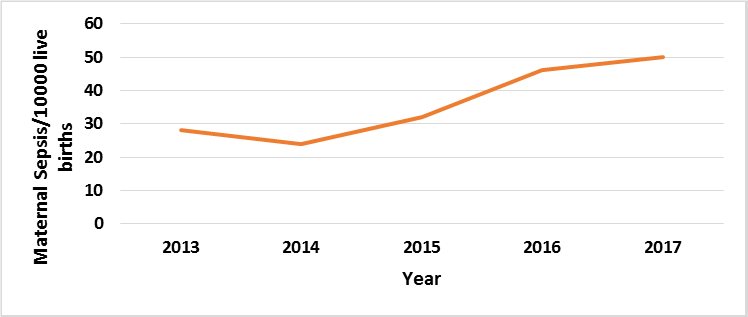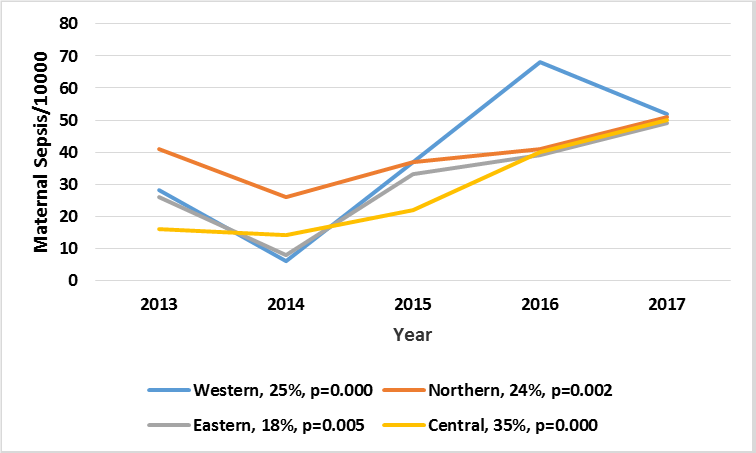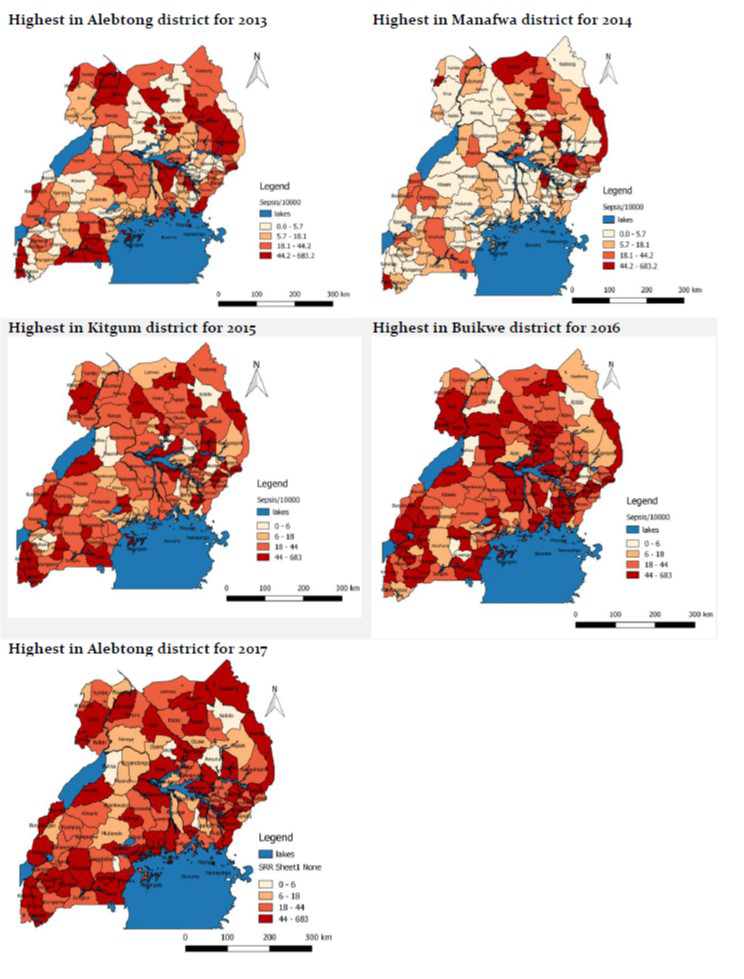Trends and Distribution of Pregnancy Related Maternal Sepsis Admissions, Uganda, 2013 – 2017
Authors: Esther Kisaakye1*, Steven Kabwama1, Daniel Kadobera1, Lilian Bulage1, Blandina Nakiganda2, Alex Riolexus Ario1
Affiliations: 1Uganda Public Health Fellowship Program, Kampala, Uganda
2 Reproductive Health Division, Ministry of Health
Summary
Maternal sepsis is the third most common direct cause of maternal mortality in Uganda but has received less attention and programming. Undetected or poorly managed maternal infections can lead to sepsis, death or disability for the mother and increased likelihood of early neonatal infection and other adverse outcomes. We assessed the trend and distribution of pregnancy-related maternal sepsis admissions at health facilities in Uganda from January 2013 to December 2017. Pregnancy related maternal sepsis admissions/10,000 live births in Uganda increased gradually from January 2013 to December 2017 and was high-est in 2017 (50/10000). For every additional year, there was a 12% in-crease in admissions due to maternal sepsis and the % increase was significant (OR=1.12, 95%CI = 1.01 -1.24, p=0.04). The northern region of Uganda was the most affected in 2013 & 2014 (2013=41/10000 & 2014=26/10000) while from 2015 to 2017, western regions of Uganda were the most affected (2017=52/10000, 2016=68/10000 and 2015=37/10000). All regions in Uganda reported cases and showed a statistically significant % increase in maternal sepsis admissions from January 2013 to December 2017: western (25%, 95%CI=1.13 – 1.39, P=0.000), central (35%, 95%CI=1.19 – 1.52, P=0.000), eastern (18%, 95%CI=1.05 – 1.33, P=0.005) and northern (24%, 95%CI=1.12 – 1.39, P=0.002). Alebtong District had the highest ratio in both 2013 and 2017, Manafwa District had the highest ratio in 2014, Kitgum District had the highest ratio in 2015 and Buikwe District had the highest ratio in 2016. We recommended effective infection control practices at health unit level and increased mobilisation and sensitisation of both health workers and mothers about cause and prevention of maternal sepsis.
Introduction
Pregnancy related maternal sepsis is a condition that can develop in; some pregnant women, women who have recently delivered a baby or babies by spontaneous vaginal delivery or by caesarean section as well as in women who have had an induced or spontaneous abortion or a miscarriage (van Dillen et al., 2010). Globally, sepsis is an important public health problem that contributes 10% to the preventable maternal mortality in low-income countries (van Dillen et al., 2010). The global maternal mortality ratio (MMR) is estimated to be at 400 per 100,000 live births. By region, the MMR was highest in Africa (830 per 100,000), followed by Asia (330 per 100,000), Oceania (240 per 100,000), Latin America and the Caribbean (190 per 100,000), and the developed countries (20 per 100,000) (Abou Zahr, 2003).
Despite being highly preventable, maternal sepsis continues to be a major cause of death and morbidity for pregnant or recently pregnant women. Also there is scanty in-formation on national level prevalence of pregnancy related Sepsis in Uganda, and yet all health facilities and district level incidence and prevalence is reported in the District Health Information System (DHIS2) every month. We assessed the trend and distribution of pregnancy-related maternal sepsis admissions at health facilities in Uganda from January 2013 to December 2017.
Methods
We obtained monthly and annual district level aggregated data on pregnancy related maternal sepsis admissions at health facilities in Uganda from the health unit in-patient monthly Health Management Information System 108 re-port (HMIS 108 IPD) from 112 districts in Uganda. We calculated admissions/10,000 live births per year and distribution by region and district. QGIS was used to map the geographical distribution by districts of Uganda. We used logistic regression to determine significance of trends and estimated the annual percentage increase in admissions due to maternal sepsis.
Results
Trend of maternal sepsis admissions at health facilities in Uganda, 2013-2017
There were 16,654 new admissions due to maternal sepsis reported from 2013-2017. The annual maternal sepsis ad-missions rate at health facilities in Uganda increased gradually from 28/10000 live births in 2013 to 50/10000 live births in 2017. For every additional year there was a 12% increase in admissions due to maternal sepsis and the % increase was significant (OR=1.12, 95%CI = 1.01 -1.24, p=0.04) (Figure 1) .

Distribution of maternal sepsis admissions at health facilities in Uganda by region, 2013-2017
The northern region of Uganda was the most affected in 2013 & 2014 (2013=41/10000 & 2014=26/10000) while from 2015 to 2017, western regions was the most affected (2017=52/10000, 2016=68/10000 and 2015=37/10000). All regions in Uganda re-ported cases and showed a statistically significant % increase in maternal sepsis admissions from January 2013 to December 2017: western (25%, 95%CI=1.13 – 1.39, P=0.000), central (35%, 95%CI=1.19 – 1.52, P=0.000), eastern (18%, 95%CI=1.05 – 1.33, P=0.005) and northern (24%, 95%CI=1.12 – 1.39, P=0.002) (Figure 2).

Distribution of maternal sepsis admissions at health facilities in Uganda by districts, 2013 – 2017
Alebtong District had the highest ratio in both 2013 (683/10000 live births), Manafwa District had the highest ratio in 2014, Kitgum District had the highest ratio in 2015, Buikwe District had the highest ratio in 2016, and Kumi District had the highest in 2017(381/10000 live births).

Discussion
Pregnancy related maternal sepsis admissions at health facilities in Uganda increased gradually from January 2013 to December 2017. This could be due to the challenges in the health systems. Even if health care is sought in Uganda, there are a number of challenges with the provision of services at the facility level. In general, there is poor population coverage for a range of maternal services (Ssengooba et al., 2003). However, this could also be attributed to poor seeking behaviours by service consumers.
Maternal sepsis admissions in Uganda were highest in western followed by northern region. Results from western region are in-agreement with findings from a study that was conducted at one of the regional hospitals in the western Uganda (Mbarara Regional Referral Hospital) where results revealed that puerperal sepsis was the leading cause of maternal deaths at that hospital (Ngonzi et al., 2016).
Additionally, according to the United Nations Children Emergency Fund report on key facts about maternal and new born health disparities in Uganda, 2011 the region with the highest coverage of skilled birth attendance was Central with 72% fol-lowed by eastern with 58%, northern with 50% and the lowest coverage was in Western with 49%. The low coverage of skilled birth attendance in western and northern Uganda could be the reason for the high maternal sepsis admissions in the regions. The low coverage of skilled birth attendance is likely associated with mothers seeking for care at later stages with complications that could predispose them to sepsis.
Conclusions and Recommendations
There was a gradual increase in maternal sepsis admissions in Uganda from January 2013 to December 2017. Maternal sepsis admissions in Uganda were highest in western followed by northern region with variations in annual distributions by district. We recommended: effective infection control practices at health unit level, and increased mobilisation and sensitisation of both health workers and mothers about cause and prevention of maternal sepsis.
References
Van Dillen, J., Zwart, J., Schutte, J., van Roosmalen, J., 2010. Ma-ternal sepsis: epidemiology, etiology and outcome. Curr. Opin. Infect. Dis. 23, 249–254.
AbouZahr, C., Aahman, E., Guidotti, R., 1998. Puerperal sepsis and other puerperal infections. Glob. Burd. Dis. Inj. Ser. 3, 191–218.
Ssengooba, F., Neema, S., Mbonye, A., Sentubwe, O., Onama, V., 2003. Maternal health review Uganda. Unpubl. Rep. Health Syst. Dev. Programme Makerere Univ. Inst. Public Health Kampala
Ngonzi, J., Tornes, Y.F., Mukasa, P.K., Salongo, W., Kabakyenga, J., Sezalio, M., Wouters, K., Jacqueym, Y., Van Geertruyden, J.-P., 2016. Puerperal sepsis, the leading cause of maternal deaths at a Tertiary University Teaching Hospital in Ugan-da. BMC Pregnancy Childbirth 16, 207.


Comments are closed.